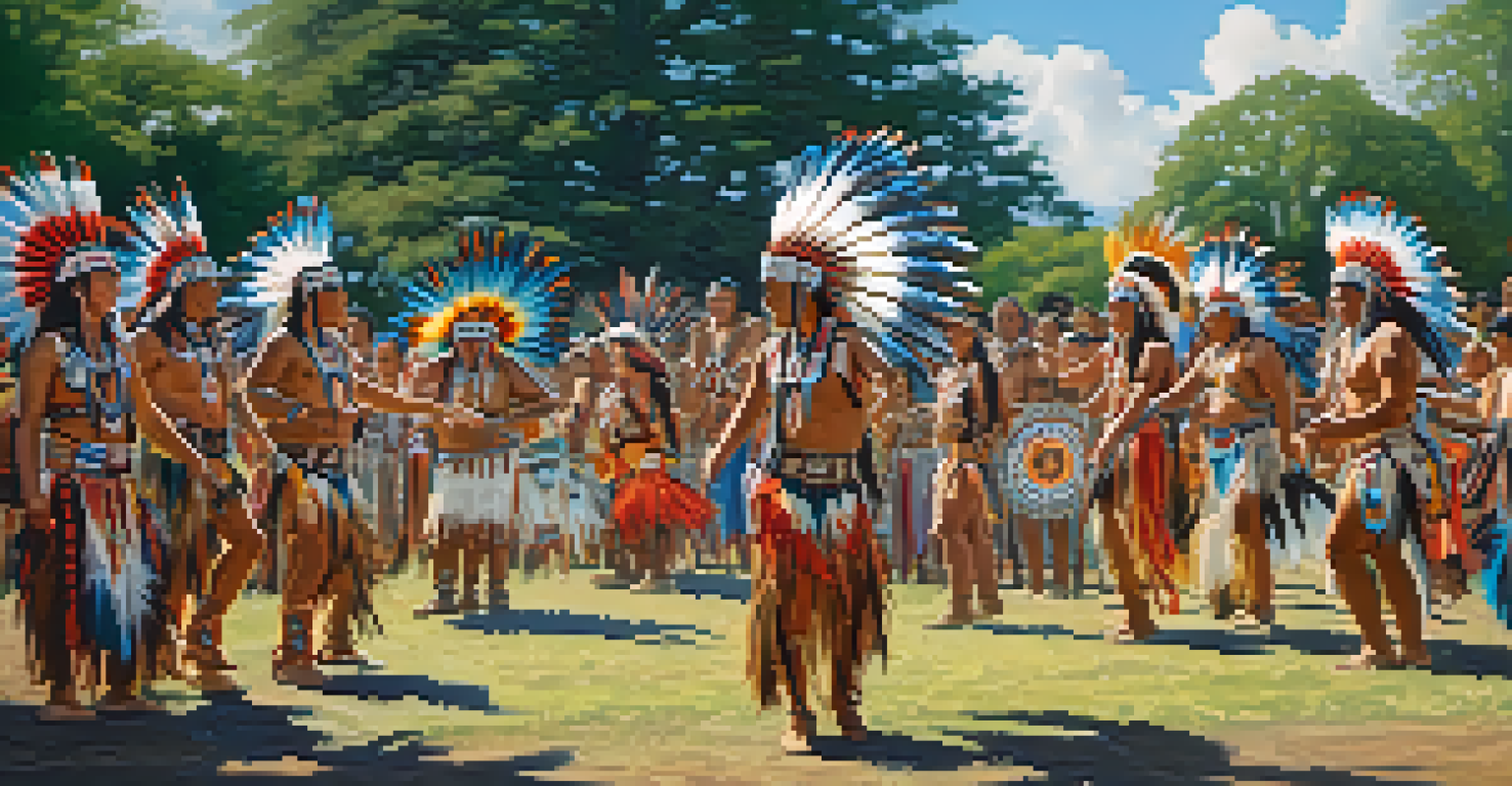Historical Overview of Native American Tribes in Kansas

The Early Inhabitants: Tribes Before European Contact
Long before European settlers arrived, Kansas was home to numerous Native American tribes, each with its unique culture and traditions. The most prominent tribes included the Kansa, Osage, Pawnee, and Wichita, who thrived in the region's rich natural resources. These tribes engaged in hunting, fishing, and agriculture, establishing vibrant communities that relied on the land's bounty.
The past is never dead. It's not even past.
The Kansa tribe, for instance, is known for their agricultural practices, cultivating crops like maize, beans, and squash. They lived in earth lodges and were skilled in trade, using the Missouri River as a vital transportation route. Similarly, the Pawnee tribe, known for their nomadic lifestyle, relied heavily on the buffalo for sustenance and materials.
These early inhabitants established a deep connection with the land, shaping their spiritual beliefs and way of life around the natural world. Their stories, traditions, and practices laid the groundwork for the cultural mosaic that would follow in Kansas.
Impact of European Colonization on Native Tribes
The arrival of European settlers in the 17th century marked a significant turning point for Native American tribes in Kansas. Colonization brought new trade opportunities, but it also introduced diseases and conflicts that devastated local populations. As settlers claimed land for agriculture, many tribes were forced to relocate, disrupting their traditional ways of life.

For example, the Kansa tribe faced significant pressure from settlers and the expanding United States government, leading to treaties that often resulted in land loss. The Osage tribe, initially prosperous, also experienced similar challenges as their territory shrank due to encroachment. These changes had lasting effects on their social structures and cultural practices.
Resilience of Native Tribes
Despite historical challenges, Native American tribes in Kansas continue to thrive through cultural revitalization and community empowerment.
Despite these hardships, many tribes adapted and fought to preserve their identity. The resilience of these communities in the face of adversity is a testament to their enduring spirit and connection to the land.
The Trail of Tears and Its Influence in Kansas
One of the most tragic chapters in Native American history is the Trail of Tears, a series of forced relocations that affected several tribes in the 1830s. While this event is most commonly associated with the Cherokee, it also impacted many tribes in Kansas, including the Shawnee and Delaware. As they were displaced from their ancestral lands, these tribes faced unimaginable hardships during their journey.
Those who cannot remember the past are condemned to repeat it.
The Shawnee, who were originally from the Ohio Valley, were relocated to Kansas in the 1830s, where they established new homes. However, the trauma of their forced removal lingered, affecting their cultural practices and community cohesion. The experience of the Trail of Tears serves as a poignant reminder of the resilience of these tribes amid profound loss and suffering.
This dark period in history has left a lasting legacy, influencing how Native American tribes in Kansas view their identity today. It serves as a powerful narrative of survival, reminding us of the importance of acknowledging and honoring their stories.
Cultural Revitalization and Modern-Day Tribes
In recent years, many Native American tribes in Kansas have been actively working to revitalize their cultures and traditions. This movement encompasses language preservation, traditional arts, and community events that celebrate their heritage. For instance, the Prairie Band Potawatomi Nation has initiated programs to teach their language to younger generations.
Additionally, events like powwows and cultural festivals have gained popularity, providing a platform for tribal members to come together and celebrate their shared heritage. These gatherings foster a sense of community and pride, encouraging younger members to connect with their roots. Such efforts not only preserve traditions but also promote understanding among non-Native communities.
Impact of European Colonization
The arrival of European settlers drastically altered the lives of Native tribes in Kansas, forcing many to adapt to new realities and often leading to loss of land and resources.
The revitalization of culture is not just about looking back; it's also about forging a path forward. By embracing their history and identity, these tribes are reinforcing their place in the broader narrative of Kansas.
The Role of Tribal Governments in Kansas Today
Today, tribal governments play a crucial role in the lives of Native Americans in Kansas. These governments are responsible for managing various aspects of their communities, including education, health services, and economic development. They work to ensure the well-being of their members while also advocating for their rights at the state and federal levels.
For example, the Kickapoo Tribe has established its own government and operates a successful casino that provides revenue for community programs. Such ventures not only boost the local economy but also help to empower tribal members. This self-determination is a vital aspect of their ongoing struggle for recognition and rights.
Tribal governments also focus on preserving cultural heritage and promoting education among their youth. By fostering a sense of identity and belonging, they ensure that the next generation remains connected to their roots, which is essential for the survival of their cultures.
Education and Awareness: Bridging Cultures in Kansas
Education plays a pivotal role in bridging the gap between Native American and non-Native communities in Kansas. Schools and educational institutions are increasingly incorporating Native American history and culture into their curricula. This inclusion helps to foster understanding and respect for Indigenous peoples and their contributions to society.
Programs like the Kansas Alliance for Native American Education aim to improve educational outcomes for Native American students while promoting cultural awareness among all students. By emphasizing the importance of Indigenous perspectives, these initiatives create a more inclusive learning environment that benefits everyone.
Education and Cultural Awareness
Efforts to include Native American history in educational curricula are vital for fostering understanding and respect between Indigenous and non-Native communities.
Moreover, community events and workshops serve as platforms for dialogue and learning, allowing for the sharing of stories and experiences. These efforts are vital in dismantling stereotypes and promoting a more accurate and respectful representation of Native American cultures.
Challenges Facing Native American Tribes in Kansas Today
Despite the progress made in recent years, Native American tribes in Kansas continue to face significant challenges. Economic disparities, health care access, and the preservation of cultural identity remain pressing issues. Many tribal members experience higher rates of poverty and unemployment compared to the general population, making economic development a priority.
Additionally, access to quality health care can be limited, particularly in rural areas. Tribes are working to address these disparities through community health programs and partnerships with local organizations. However, the ongoing effects of historical trauma can complicate these efforts, impacting the overall well-being of tribal communities.

Furthermore, the challenge of preserving cultural identity in an ever-changing world persists. As younger generations navigate modern society, finding a balance between contemporary life and traditional practices is essential for the survival of their heritage.
Looking Ahead: The Future of Native American Tribes in Kansas
As we look to the future, the resilience of Native American tribes in Kansas remains a source of inspiration. The commitment to cultural revitalization, education, and community empowerment sets the stage for a brighter future. By fostering strong connections within their communities and engaging with broader society, these tribes are paving the way for future generations.
Moreover, the increasing recognition of Indigenous rights and sovereignty at the national level offers hope for positive change. Collaborations between tribal governments and state authorities can lead to improved resources and opportunities for Native American communities. This partnership is essential in addressing historical injustices and building a more equitable society.
Ultimately, the future of Native American tribes in Kansas is one of resilience, growth, and hope. By honoring their past while embracing modernity, they are not only preserving their heritage but also enriching the cultural landscape of Kansas as a whole.